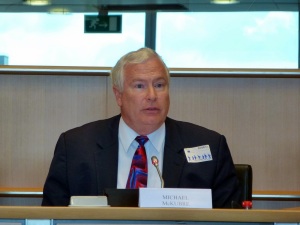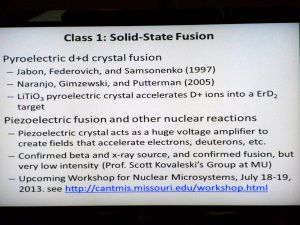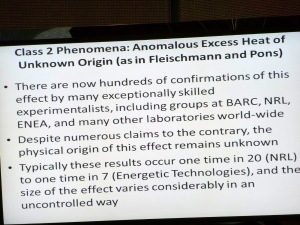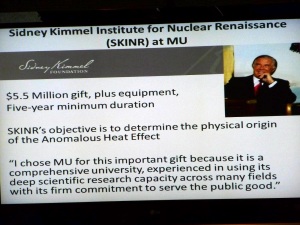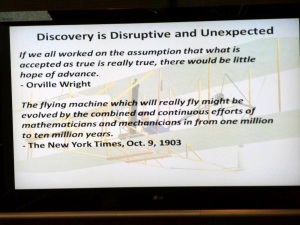By Dr. Michael McKubre, Director of the Energy Research Center of the Materials Research Laboratory at SRI International
These are exciting times and Rossi (and his sponsors) and the research team of Levi, Foschi, Höistad, Pettersson and Tegnér, as well as Hanno Essén, are to be commended for their tenacious pursuit of what at times must have seemed a thankless job. The world looks forward to more. – Michael C.H. McKubre
Originally posted @ www.infinite-energy.com/
A team of scientists from Italy and Sweden have released a second, more substantive test analysis of the Andrea Rossi E-Cat. The report, “Observation of Abundant Heat Production from a Reactor Device and of Isotopic Changes in the Fuel” , was released on October 8 based on a 32-day test done in March 2014. The same team (Giuseppe Levi, Evelyn Foschi, Bo Höistad, Roland Pettersson, Lars Tegnér, Hanno Essén) tested an earlier version of the E-Cat in spring 2013 and released a similar, though not as conclusive, report. The new report concludes with a clearly written and positive statement:
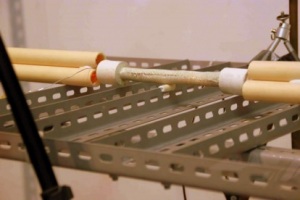
In summary, the performance of the E-Cat reactor is remarkable. We have a device giving heat energy compatible with nuclear transformations, but it operates at low energy and gives neither nuclear radioactive waste nor emits radiation. From basic general knowledge in nuclear physics this should not be possible. Nevertheless we have to relate to the fact that the experimental results from our test show heat production beyond chemical burning, and that the E-Cat fuel undergoes nuclear transformations. It is certainly most unsatisfying that these results so far have no convincing theoretical explanation, but the experimental results cannot be dismissed or ignored just because of lack of theoretical understanding.
All well and good. Is this confidence justified by the words in the report? Is there evidence of excess heat? My impression is “Yes” (but see below). Is this evidence unambiguous? Not as presented. Is there evidence of nuclear transformation? Yes, very clearly, but questions remain to be answered (or, in some cases, asked). Do the heat and nuclear production correlate quantitatively? Yes, possibly. Is the report perfect? No, no report is perfect, but this one is imperfect in little ways and large. There is curious inattention to detail—surprising for a document as delayed, anticipated and important as this. When asked to provide a review (sight unseen) I agreed; this is important. But I also realized that unless the report was perfect in every detail, whatever I wrote would annoy somebody. Here goes.
For the proponents of condensed matter nuclear science (CMNS) this report provides valuable impetus and strong support for the case that nuclear effects occur (implicitly by novel pathways) in the solid state. More importantly, the report provides concrete and testable information about fuel and products, potentially of two separate branches of CMNS, of the sort to make theorists on both sides of the “reality question” very happy indeed. Have we risen to the standard of Dick Garwin’s “undoubtedly”? No, although he should be happy that multiple cups of tea might soon be available—perhaps on demand.
Although highly interesting, this report has problems at several levels that render direct interpretation difficult or impossible without further information and clarification. This is a shame and undoubtedly a source of great frustration to the CMNS community. There are substantive missing or broken issues dealing with the essential issues of calorimetry and sampling. There are also “minor” or ancillary points that I will attempt to outline to improve technique and reporting. The latter do not change the conclusions but do affect credibility. You will note that this review contains more questions than answers. Not all of these questions required answers before the experiment was run or the report written but, in my view, many of them should have been addressed.
Let’s start with the calorimetry, the balance (or reported imbalance) between power input and power output. We begin with the input energy. I have only minor issues with the technique employed for input power measurements and the interpretation of values. Measurement of three-phase power is a standard matter that is critical in numerous industries. The community of scientists and engineers knows how to do this precisely and accurately on scales extending from well below to well above the power levels in this experiment. There is every indication that the authors of this report are well aware of possible pitfalls and have taken care to address them. They address the issue of unmeasured current flowing in unseen “ground loops” by employing similar meters upstream and downstream of the load. These meters have harmonic monitoring capability in case unmeasured high frequency components contribute significantly to the input energy. As has been demonstrated many times (and again in this report) neither issue is “really real.” But questions have been asked about other similar experiments; this report anticipates them and answers them, before being asked.
First class, perhaps overkill, but one issue I have with the input power measurement is that the claimed uncertainty of ±10% seems far too large. My colleagues and I have considerable experience with almost identical measurements over a range of power scales from the small to the large. After ICCF17 in 2012, Fran Tanzella and I traveled to China to conduct power measurements and perform “calorimetry” on the 100-200 KW scale which we were able to accomplish effectively at the ±1% level of accuracy in an industrial setting using WattNode power-to-pulse converters. These meters are cheap and reliable, and can be used with good accuracy provided that current sensors are well matched to the voltage and current. For any sort of electrical engineer the measurement of power delivered is a “no brainer.” This is not an issue for this report but I would like to see the authors re-think and re-justify their asserted levels of accuracy in input power and energy measurement.
The report states: “The reaction is primarily initiated by heat from resistor coils around the reactor tube.” Do we know that this is the configuration (were the authors permitted post-test examination)? What does “primarily” mean? The report states: “In addition, the resistor coils are fed with some specific electromagnetic pulses.” What kind of electromagnetic stimulation? How much? How was this measured? When? Why? I do not expect an answer to the last but the rest need to be addressed quantitatively.
As a final point on input power I was surprised to see that this was measured not at the “calorimetric boundary” but at the power supply. This necessitates a correction to the power delivered to the test since the lead wires have resistance. The correction is small and appears to have been done correctly. It is, however, always better to avoid mathematical corrections by placing the voltage sense contacts at the points that define the boundaries of the interrogated heat.
The mode of calorimetry employed to measure the output power and by integration energy, is one with which I have little direct hands-on experience. When I first read the report I was inclined to accept the output power measurement at levels of say ~±10% accuracy (subject to quantitative verification using a finite element heat model). [Note that the report assigns ±1% to the accuracy of the output and ±10% to the input.] My intuition/experience would reverse these numbers. Heat lost from hot objects by convection and radiation is, like electrical power measurement, a very standard and well-documented engineering procedure with history extended back over 100 years. We know how to do this. Having said that, the complexity (and uncertainty) of the E-Cat structure render the interpretations “difficult,” or worse, “ambiguous.” Are these difficulties and ambiguities sufficient to negate the value of the report? I don’t think so, but verification is required. Let’s look at some of the issues.
Of primary concern is the complete absence of relevant pre- or post-test calibration. The mathematical description of heat losses from a structure with multiple parts and awkward geometry is not difficult but contains many terms and several assumptions. Perhaps with more direct experience I could trust the equations and assumptions to do their job, but I do not have that experience. Neither do the authors, nor does most of the “audience.” The only way to handle such uncertainty is via relevant calibration, ideally under identical conditions at and surrounding the operating point. The calibration that was performed was at a single point well below the points of ultimate operation. This is bad and bad. We need to determine the shape of the performance manifold empirically, ideally bracketing all points of operation. This was not done.
The “active” experiment operated at two base levels of heat output: ~1250W and ~1400W. The report says that dummy power was limited to 500 W. Even if the system had simple geometry and the calibration function was linear this would be an extraordinary departure from accepted and acceptable protocols. The explanation given for this divergence is not plausible. The authors claim that “some Inconel cables have a crystalline structure that is modified by temperature, and are capable of withstanding high currents only if they are operated at the appropriate temperature. If these conditions are not met, microscopic melt spots are liable to occur in the cables.” Even if true the options are several:
1) If you really cannot (or are not permitted to) operate above 500 W, use three calibration steps (say 300, 400 and 500W) to determine the shape of the calibration manifold. Extrapolation is bad but better than nothing.
2) Slowly increase the power while monitoring the resistance to anticipate and avoid “microscopic melt spots” by observing (and avoiding) points at which resistance rises rapidly in an unexpected profile.
3) Employ Joule calibration after the test when the operating regime has been determined. The internal sense control thermocouple (whose data are missing from the report) could easily be re-inserted after the products have been removed and then re-bonded into place for calibration.
The inability or unwillingness to do one or all of these things is a glaring deficiency in the thermal output record. That is not to say that this record is incorrect, but we cannot be certain that it is correct and the measurement uncertainty is undefined.
In the absence of calibration suitable and sufficient for accurate quantification, what can we learn qualitatively using the experimental data from the active run as its own “self-calibration”? On page 7 of the report the authors state: “Subsequent calculation proved that increasing the input by roughly 100 watts had caused an increase of about 700 watts in power emitted.” This is interesting. The shape of the output vs. input power curve is observed (or implied) to strongly curve upwards in a manner completely inconsistent with the Stefan-Boltzmann law for radiative heat loss. It is also inconsistent with simple convective heat transfer but several issues need to be addressed before we can claim this as a qualitative or even “semi-quantitative” measure of excess heat production:
1) The issue of alumina emissivity is adequately handled in the report (it is needed to calibrate the temperature measurements) but not the issue of transparency. Without getting too technical, the rate of radiant heat release is determined optically. At issue is the extent to which the camera measures directly the temperature of the heating wires and the putative source of the “fuel” directly transmitted through the alumina container, rather than the surface as assumed in the heat calculations. This is not an area of my expertise. The arguments are subtle and may result in under, over, or accurate measurement of radiant heat loss rate.
2) No independent temperature measurement is provided of the contents internal to the E-Cat where the heat sources are located. Such a sensor was apparently present but the data were not provided or (apparently) analyzed. This is of concern as these data could provide strong supporting evidence for the radiant heat calculation and Point 1. Furthermore, nickel melts at 1455°C and the different Inconel alloys melt in the range 1390 – 1425°C, with the surface temperature stated in the report to reach 1412°C, and the heat sources known to be inside. Thus the “fuel or catalyst” (Ni), the heater wires and the inserted thermocouple sheath are all at significant risk of melting if the optically determined alumina surface temperature is correctly measured. Was this measurement correct or was the reactor on the cusp of failure when it was shut down?
3) Radiant heat loss rates increase with temperature so (ignoring the issues of Point 1) an increase of ~700 W output caused by ~100 W increase in input is definitely not expected. The other major term is convective loss, which increases roughly linearly with temperature so that such a steep upturn would be unexpected. However, convective losses are strongly affected by air movement both natural convective eddies and bulk air movement. No attempt was made to control air movement using closures or shields so the convective state of the air surrounding the E-Cat source is unknown and cannot be determined. The “good news” is that when the maximum output was achieved at 906 W input, and 2886 W total output, the convective loss term was only ~15% (431 W) so we really only need concern ourselves with convection (at the, say, 10% accuracy level).
I could go on. There are many tiny details of calorimetry that need better exposition and it is to be hoped that this will occur through open discussion.
I now turn attention to the “fuel” and products, and sampling. The fueling process is described in the report thusly:
After 23 hours’ operation, the dummy reactor was switched off and disconnected from the power cables, to allow for one of the caps to be opened and the powder to be inserted. The powder had been previously placed in a small envelope, weighed (about 1 g), and then transferred to a test tube so that Bianchini could perform radioactivity measurements on it, after placing it in a low background lead well. Lastly, the contents of the test tube were poured inside the reactor, in the presence of a member of the experimental team.
From the perspective of a chemist I have several issues with this stated procedure. A small envelope? What kind of envelope? About 1 g? How much mass exactly? How was the starting sample taken? By whom, with what tools, using what procedure? The report states, “It should also be noted that our total sample was about 10 mg, i.e. only a small part of the total fuel weight of 1 g used in the reactor. The sample was taken by us at random from the fuel and ash, observing utmost care to avoid any contamination…An arbitrary sample of different granules is chosen for the analysis.” How big is a granule? How many were selected? One percent (10 mg of ~1000 mg) is a pretty small sampling unless we can trust the randomness of the sample. How was sampling randomized? By whom was this done using what criteria?
The report states: “The reactor…is charged with a small amount of hydrogen-loaded nickel powder plus some additives, mainly lithium” but also “it is plausible that the fuel is mixed with the standard lithium aluminum hydride, LiAlH4. Further evidence of that is obtained from the ICP-AES analysis which shows that the mass ratio between Li and Al is compatible with a LiAlH4 molecule.” I do not want to quibble but LiAlH4 is not mainly Li. And the fate of the Al is not mentioned in the analysis of the products. This might be a nice marker of metal loss and isotopic shifts, especially since natural Al is mono-isotopic.
All this is minor detail that should nevertheless have been addressed. What is not minor is the fact that Rossi himself made the fuel addition (using an undescribed procedure) albeit “in the presence of a member of the experimental team.” The fact that the reactant was inserted and extracted by Rossi with his own hands does not invalidate the technical data. After all, this is how most experiments are performed without chaperone. It does raise a question however and all questions unanticipated and unanswered in a report (particularly one of this potential consequence) tend to diminish credibility and thus significance.
Finally we get to products. When reading the report for the first time the thing that struck me with greatest pleasure was the apparent isotopic transformation from fuel to product. So many of us for so many years have been stating: “Show us evidence of nuclear products with non-natural isotope distributions and we will believe that the element was created or transformed.” This report presents clear evidence thusly: “The lithium content in the fuel is found to have the natural composition, i.e. 6Li 7% and 7Li 93%. However at the end of the run a depletion of 7Li in the ash was revealed by both the SIMS and the ICP-MS methods. In the SIMS analysis the 7Li content was only 7.9% and in the ICP-MS analysis it was 42.5%.” This finding is taken to a logical conclusion with an argument relating mass transformation to energy. The report speculates: “the depletion of 7Li might be due to the reaction p + 7Li arrow 8Be arrow 4He + 4He” and goes on to calculate: “If each 7Li nucleus releases about 17 MeV we find then that the total energy available becomes 0.72 MWh. This is less than the 1.5 MWh actually produced in our 32 days run, so more energy has to come from other reactions.”
Other reactions apparently occur: “Evidently, there is also an isotope shift in nickel. There is a depletion of the 58Ni and 60Ni isotopes and a buildup of the 62Ni isotopes in the burning process.” There is, however, no attempt at a mechanism or an energy calculation to rationalize the missing ~50% energy beyond a repeated wistful appeal to the “Coulomb Barrier” that has relevance only to the pairwise interaction of charged nuclei (that clearly did not happen).
In addition to an evident lack of even an overall mechanism to explain half of the produced energy several other problems occur:
1) If one were to reshuffle the neutrons of the five stable Ni isotopes in the directions of the revealed changes we would have a great deal of energy—possibly far too much, in fact, depending on the sources of the “new” neutrons.
2) If the “fueling” of the Ni half of the putative excess heat involves the Ni light isotopes, all of these are essentially depleted and yet the reactor was continuing to increase its rate of energy production (excess power). Rates of reaction are not expected to increase (one might state more strongly “are known not to increase”) with near complete loss of fuel. If the reactor had been run for a day or two more would we have seen the rate of heat evolution decline to zero?
3) One might perhaps argue that the Ni was “burned” first before the reaction started to consume 7Li but this brings up another issue. Whatever mechanism we postulate for the “Ni burn” this is hardly likely to be in any way similar to that tentatively proposed for Li. This means that we are required to explain not one but two new processes that occur under near-identical conditions.
4) The authors commenting on their analyses state that some elements present in the fuel samples are not present in the product samples. Just as for Al these elements are markers. We have three possibilities: (i) these contaminants (or deliberate additives) are participating in the reaction; (ii) they volatilized and exited an imperfectly sealed reaction chamber; (iii) the starting and ending “samples” are not the same. Whichever, I would like to know the answer and see some discussion of it. Possibly this is poor wording but it needs to be made clear.
5) I took issue with the insufficiently well specified process of sampling the fuel mix prior to introduction into the E-Cat. The product sampling is even less well specified and described. How was this done? Who was present? Who did what with what apparatus? Was this recorded on video? What was the chain of custody of possibly the single most important sample ever generated in CMNS studies? The authors and workers had no reason except their calorimetric results to believe that the sample was as important as it apparently was. But just to make sure we need to develop an agreed upon sampling technique and establish a documented chain of custody for any future samples. A mandatory requirement for an independent test is an effective decoupling of interested parties from significant activities.
And there must be future samples. This was not a replication of a previous demonstration. Rossi clearly had experience with this device operating in this mode but for the authors of the report this was a new and one-off experiment. One experimental result equates to zero experimental results. Nothing in science can be known without repetition.
As a final non-technical point, let me extol the virtues of technical and copy editing. I realize this report has not been submitted for publication and is therefore “in process” but little things distract from the bigger points that are being argued. In the conclusion the report states: “the ash composition from SIMS is: 58Ni (0.8.%), 60Ni (0.5%), 61Ni (0%), 62Ni (98.7%), 64Ni (0%).” These percentages add to 100.4% because the 58Ni analysis is mis-quoted from Appendix 4 which states 0.3% for this isotope. The natural abundance of Ni isotopes quoted throughout the report add to 100.6% because the abundance of 61Ni is listed as 1.8% in the report rather than 1.14%, according to Wikipedia. This does not make any difference to the conclusions but the reader is forced to ask “if these small details are wrong what else might be?”
On the whole I am encouraged. Considerably more work is obviously needed to validate the adopted mode of calorimetry and support better sampling and testing. But we are given something we can sink our teeth into both experimentally and theoretically: testable fuel(s) to products(s) nuclear burn at temperatures that have practical, economic and social potential. These are exciting times and Rossi (and his sponsors) and the research team of Levi, Foschi, Höistad, Pettersson and Tegnér, as well as Hanno Essén, are to be commended for their tenacious pursuit of what at times must have seemed a thankless job. The world looks forward to more.
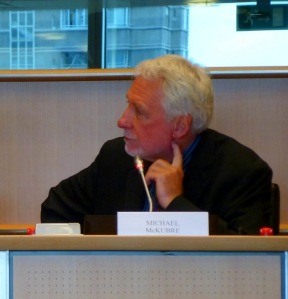
About the Author: Dr. Michael McKubre is Director of the Energy Research Center of the Materials Research Laboratory at SRI International. He received B.Sc., M.Sc. and Ph.D. in chemistry and physics at Victoria University (Wellington, New Zealand). He was a Postdoctoral Research Fellow at Southampton University, England. Dr. McKubre joined SRI as an electrochemist in 1978. He is an internationally recognized expert in the study of electrochemical kinetics and was one of the original pioneers in the use of ac impedance methods for the evaluation of electrode kinetic processes. Dr. McKubre has been studying various aspects of hydrogen and deuterium in metals since he joined SRI in 1978, the last 25 years with a close focus on heat measurements. He was recognized by Wired magazine as one of the 25 most innovative people in the world. Dr. McKubre has conducted research in CMNS since 1989.
*Email: michael.mckubre@sri.com


